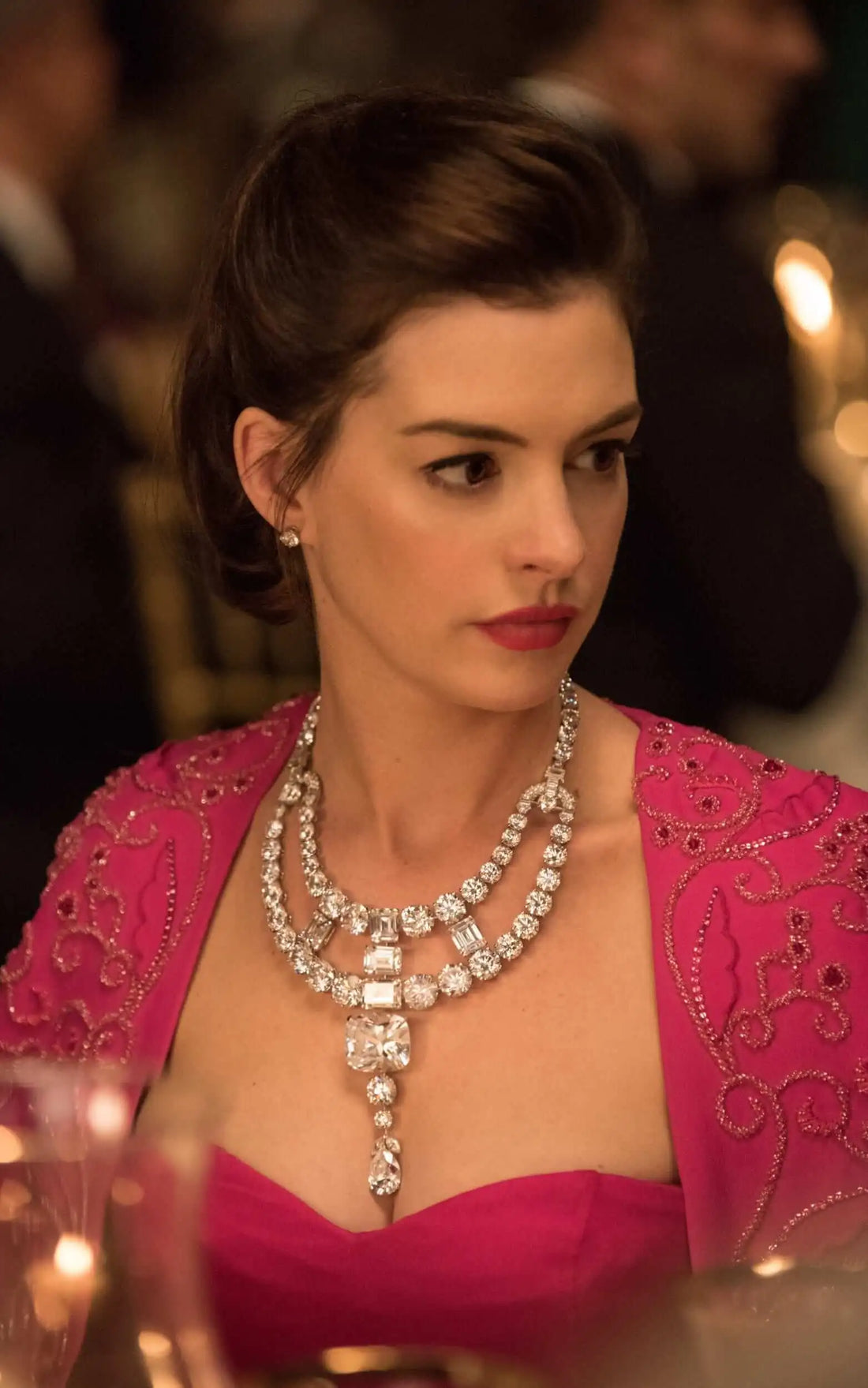Valuable gemstones or very expensive jewellery as central subjects of a story are not rare choice in filmmaking, one the latest interesting cases being Ronnie Thomson’s “The Hatton Garden Job” (2017) based on a true story that took place in London’s famous gem and jewellery district in 2015. Examples are numerous, from hilarious stories like Blake Edwards’ “Pink Panther” (1964), staring Peter Sellers; Charles Cricton's “A Fish Called Wanda” (1988), starring John Cleese and Jamie Lee Curtis; and Guy Richie’s “Snatch” (2000), starring Brad Pitt, Benicio del Toro and Jason Stathan, to more serious plots, like the classic Alfred Hitchcock “To Catch a Thief” (1955) and Michael Radford’s “Flawless” (2007) staring Michael Caine and Demi Moore, just to name a few.
Along these lines, in 2004 film director Steven Soderbergh makes a sequel of his 2001 blockbuster “Ocean’s 11” (a remake of the 1960 film by Lewis Milestone staring Dean Martin, Frank Sinatra and Sammy Davies Jr, among others) where Daniel Ocean (George Clooney) and his 12 con partners, hence the title “Ocean’s 12”, plan to rob a famous Fabergé Imperial Coronation Egg.

The egg was presented by Emperor Nicholas II of Russia to his wife, Empress Alexandra Feodorovna in 1897 to celebrate the day of their coronation the year before. Multi-coloured gold, translucent yellow guilloché enamel, black enamel and diamonds are set in a majestic fashion. Inside the egg there is a diamond and ruby set enamelled gold and platinum miniature replica of the original 18th century carriage by Buckendahl. In 1979, Malcom Forbes payed $2,16 million for the egg and, in 2004, after being announced for sale in Sotheby’s along with other Fabergé Imperial eggs, Viktor Vekselberg, chairman of the Renova Group, reportedly bought it privately for an undisclosed amount (it is said that he payed just over $100 million for 9 eggs). Today, it is part of the Fabergé Museum in St. Petersburg, Russia.
The superior real and perceived value of such an iconic unique work of jewellery art and its outstanding historical importance were a more that valid argument to establish a screenplay in the style of Soderbergh’s previous Ocean’s movie.
The “Ocean’s 8” Necklace
After several other sequels of Danny Ocean’s adventures, the franchise moved to the next level and Gary Ross and Olivia Milch wrote a story where Denny’s sister, Debbie Ocean, gathers an all-female crew to attempt an apparently impossible heist at New York City's yearly Met Gala. The action of “Ocean’s 8”, starring Sandra Bullock, Cate Blanchett, Anne Hathaway, Mindy Kaling, Sarah Paulson, Awkwafina, Rihanna and Helena Bonham Carter, directed by Gary Ross, is set around robbery of the famous Toussaint Diamond Necklace by Cartier, kept in a vault for 50 years and to be worn by Daphne Kluger, a Hollywood actress played by Anne Hathaway, on the famed Met Gala.

The necklace is not a complete invention and it actually existed. It was originally designed in 1931 by Jacques Cartier (1885-1942), the grandson of the founder of the Maison Cartier (Louis-Francois Cartier), to the Maharajah of Nawangar, also known as Maharajah Jam Shaheb. The Maharajah, known for his lavish taste was a connoisseur of fine jewellery and established a close friendship with the french jeweller, that referred to the ruler as “Jam”, to whom he commissioned very important pieces, including some astonishing emerald jewellery, a much cherished gemstone among the Maharajahs. The cerimonial diamond necklace was a masterpiece of its own, featuring colourless and fancy coloured diamonds from both Cartier’s stock and the Maharajah’s personal collection, being “a really superb realisation of a connoisseur's dream” in Jacques Cartier’s own words. The Indian ruler did not, however, have much time for the fruition of such a sublime creation since he passed away two years after Cartier finished it.

In the photo: The Maharajah of Nawangar (1862-1933) handling the stunning diamond necklace designed by Jacques Cartier in 1931 © Cartier Arquives
Among the featured gems, fancy colours like pink, blue, yellow and green can be seen on the original sketch, but probably the most important one is the Queen of Holland, a 136,25 ct colourless diamond cut by F. Friedman & Co. in Amsterdam in 1904 from a reportedly South African rough, baptised in honor of queen Wilhemina of the Netherlands (1880-1948). The stone, a D-Flawless cushion shaped diamond (the top grades for colour and clarity in the International Diamond Grading System of the Gemological Institute of America introduced in the 1950’s) was subsequently bought by the Maharajah of Nawangar. As an historical curiosity, this diamond was later acquired by Cartier in 1960, repolished by New York’s William Goldberg to its present 135,92 ct in 1978 and was sold in the 1990’s to Robert Mouawad, the famous Lebanese jeweller, for a sum believed to be in the $7.000.000 tag.
Behind the Scenes of a Jewelled Prop
The necklace, represented in the film as the Toussaint Necklace, is a tribute to Jeanne Toussaint, creative director of Cartier in the 1930’s that played a key role in the establishment of a stylistic identity for the brand, being the first woman to stand out in Cartier’s creative spirit. As a plot in the feminine, such a homage was in more that in order in light of woman empowerment mission embraced by Cartier.

The original sketch of the original necklace designed by Cartier. The coloured diamonds in the project are clearly visible © Cartier Archives
The actual Maharajah’s necklace no longer exists, but Cartier kept in its treasured archives the primordial sketch that was, as in the original, the base for the manufacture of a brand new artefact specially for the film. Then, based on that very original drawing, the “Toussiant” was manufactured in a record time of only less that two months at the Maison’s workshops at the mythical the Rue de La Paix, in Paris, way less that the time that took to assemble the original Maharajah’s ceremonial piece. The materials used by the skilled jewellers were white gold and colourless cubic zirconias, or CZ, a rather common diamond simulant developed in the former Soviet Union in the 1970’s. The choice was obvious since well fashioned cubic zirconias are visually similar to cut diamonds and can be produced in large sizes. No coloured stones were used in the film version of the necklace, a quite important detail that differentiates it from the original where fancy coloured diamonds were set. Another difference is the size of the necklace. The original was made for a man and Cartier cleverly decided to reduced its size by 15-20% with detachable elements to make it more suitable for the elegant Anne Hathaway who’s character would use the jewel in the story. Although the necklace was a mere film prop, a special care was taken in its sturdiness and finishings to make sure all the metal elements, settings and stones, were properly set as a high-end jewel of Cartier’s caliber and that the piece could withstand the intensive handling of a prop on set. In the close ups of the necklace during the movie, the quality of the manufacture stands out even for a jewellery savvy viewer and this is remarkable to witness in a motion picture.

In the photo: detail of the cubic zirconia settings in the necklace prop being made in Paris © Cartier
Cartier joined Warner Brothers, in association with Village Roadshow Pictures, as the exclusive jewellery partner for Ocean’s 8, recreating and reinterpreting a multimillion dollar necklace for the story. Cartier has also provided fine jewellery and time pieces of their own stock and collections to be used by the actors on set during a five day film shooting period at the Metropolitan Museum of Art in New York where the Gala takes place. This means that, all the jewellery featured in the movie are actually real, not dummy props. A few scenes were also filmed at the iconic 52th Street with Fifth Avenue Cartier headquarters, an historical mansion designed by architect Edward W. Gibson for Morton Freeman Plant (1852-1918) in Manhattan that was the theme of another blog post here somewhere in this blog!
The comic and intriguing story, in the best spirit of the previous titles of Ocean’s sagas, is not only a great option for an amusing evening at the movie theatre, but absolutely a must for gem and jewellery history lovers. The story now revealed behind the production of this film is a great argument for gem geeks to go to the movies!

Unless otherwise stated, all images are by Barry Wetcher © 2018 Warner Bros. Entertainment Inc. Courtesy of Cartier

